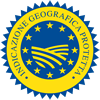Description
The Marrone di Roccadaspide PGI refers to the fresh or dried fruit belonging to the species Castanea sativa M., deriving from the Anserta, Abate and Castagna Rossa ecotypes of the Marrone variety.
Production Area
The production area of Marrone di Roccadaspide PGI is within about 70 municipalities in the Province of Salerno, in the Campania region.
Production Method
Harvesting takes place during autumn and must be completed within the first ten days of November. It is carried out either by hand or with harvesting machines which guarantee that the product remains whole. To increase their shelf life, the chestnuts are immersed in cold water, a traditional method known as “curatura” (dipping) that lasts for nine days, during which time the water is changed. The selected fruits are then arranged on layers of sand in well-ventilated rooms. The chestnuts destined to be sold as a dried product are dried either in metati (small buildings made of stone or brick) or on trellises, with a slow and continuous flame that is fuelled with branches collected in bundles or wood, depending on local traditions.
Appearance and Flavour
Marrone di Roccadaspide PGI is large in size, with a maximum of 80-85 fruit per kg, and is a typical semi-spherical or slightly ellipsoid shape. It has a thin chestnut-brown skin that is easy to remove; the seed also has a thin smooth shell. The pulp is milky-white, with a uniform, crunchy and not particularly floury texture. It has a remarkably high sugar content.
History
Marrone di Roccadaspide PGI has been linked to the history of this region for an extremely long time, with the cultivation of chestnuts documented since the 9th century AD. Valuable manuscripts kept in the Badio di Cava archives describe their presence in the Cilento area as early as 1183-84. The value of chestnuts was linked to the importance of chestnut flour, which between the Middle Ages and the late 19th century was used to produce a special kind of long-lasting bread. This bread proved vital for the survival of the population of Roccadaspide during the Second World War. After the war, the economic reconstruction of this town was also possible thanks to the chestnut production that had contributed to the development of the farming civilization. At the end of the 19th century, the old secular and majestic trees were chopped down and grafted with the Castagnera Rocca species, today known as Marrone di Roccadaspide PGI.
Gastronomy
Marrone di Roccadaspide PGI has a long shelf life. It can be eaten fresh, in the form of flour, or transformed by the confectionary industry into Marron Glacé, jams, puree or chestnuts in rhum. It is greatly sought after due to its size, which makes it ideal for roasting, and is a quality raw ingredient in many delicious traditional local desserts. The product is also used in main courses, or served as a side dish to game meat. From a dietary and nutritional point of view, Marrone di Roccadaspide PGI is particularly important for its high content of carbohydrates and low protein content.
Marketing
The product is marketed as Marrone di Roccadaspide PGI, fresh and dried, with the shell or shelled. It is available during the autumn months and is sold in fabric bags, wicker containers, paper bags, and boxes made of plant-based materials. They can also be sold vacuum-packed and in glass recipients.
Distinctive Features
Marrone di Roccadaspide PGI is characterised by its large size and high sugar content, which gives the chestnut a sweet and extremely pleasant flavour. The seed is very easy to peel thanks to the low percentage of splitting, which means that the skin does not penetrate deeply into the pulp.



















